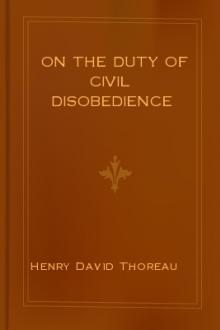Essays Henry David Thoreau (little bear else holmelund minarik .txt) 📖

- Author: Henry David Thoreau
Book online «Essays Henry David Thoreau (little bear else holmelund minarik .txt) 📖». Author Henry David Thoreau
Night came on before we had passed the high banks. We had come from Montreal to Quebec in one night. The return voyage, against the stream, takes but an hour longer. Jacques Cartier, the first white man who is known to have ascended this river, thus speaks of his voyage from what is now Quebec to the foot of Lake St. Peter, or about halfway to Montreal: “From the said day, the 19th, even to the 28th of the said month, [September, 1535] we had been navigating up the said river without losing hour or day, during which time we had seen and found as much country and lands as level as we could desire, full of the most beautiful trees in the world,” which he goes on to describe. But we merely slept and woke again to find that we had passed through all that country which he was eight days in sailing through. He must have had a troubled sleep. We were not long enough on the river to realize that it had length; we got only the impression of its breadth, as if we had passed over a lake a mile or two in breadth and several miles long, though we might thus have slept through a European kingdom. Being at the head of Lake St. Peter, on the abovementioned 28th of September, dealing with the natives, Cartier says: “We inquired of them by signs if this was the route to Hochelaga [Montreal]; and they answered that it was, and that there were yet three days’ journeys to go there.” He finally arrived at Hochelaga on the 2nd of October.
When I went on deck at dawn we had already passed through Lake St. Peter, and saw islands ahead of us. Our boat advancing with a strong and steady pulse over the calm surface, we felt as if we were permitted to be awake in the scenery of a dream. Many vivacious Lombardy poplars along the distant shores gave them a novel and lively, though artificial, look, and contrasted strangely with the slender and graceful elms on both shores and islands. The church of Yarennes, fifteen miles from Montreal, was conspicuous at a great distance before us, appearing to belong to, and rise out of, the river; and now, and before, Mount Royal indicated where the city was. We arrived about seven o’clock, and set forth immediately to ascend the mountain, two miles distant, going across lots in spite of numerous signs threatening the severest penalties to trespassers, past an old building known as the Mac Tavish property—Simon Mac Tavish, I suppose, whom Silliman refers to as “in a sense the founder of the Northwestern Company.” His tomb was behind in the woods, with a remarkably high wall and higher monument. The family returned to Europe. He could not have imagined how dead he would be in a few years, and all the more dead and forgotten for being buried under such a mass of gloomy stone, where not even memory could get at him without a crowbar. Ah! poor man, with that last end of his! However, he may have been the worthiest of mortals for aught that I know. From the mountaintop we got a view of the whole city; the flat, fertile, extensive island; the noble sea of the St. Lawrence swelling into lakes; the mountains about St. Hyacinth, and in Vermont and New York; and the mouth of the Ottawa in the west, overlooking that St. Ann’s where the voyageur sings his “parting hymn,” and bids adieu to civilization—a name, thanks to





Comments (0)